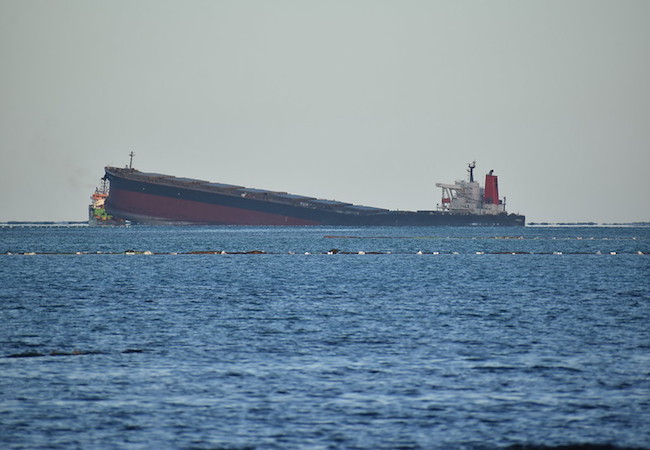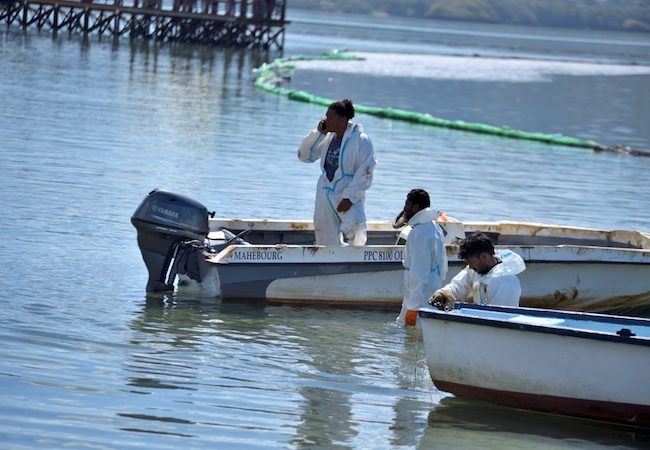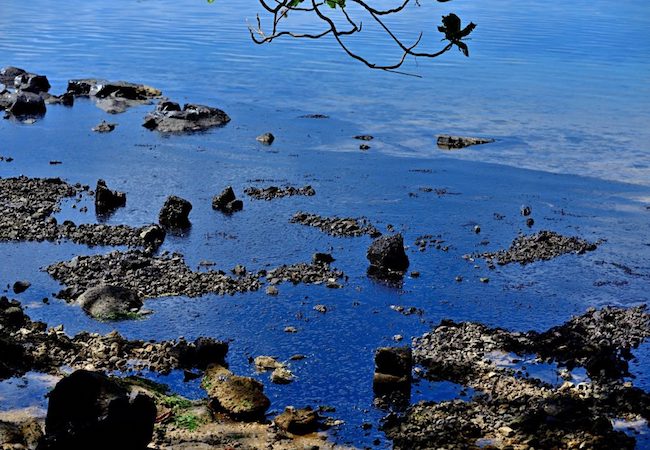
By Christian Bueger
The devastating oil spill that wreaked havoc on Mauritius’ coastline raises the question of whether the response by the government was appropriate. Was the country unprepared for a disaster of this scale? Were officials over-confident or misjudged the risk?
Evidence indicates that Mauritius was very well prepared; the event did not come as a surprise. Importantly, the country dealt with similar incidents very successfully before. Yet, a public inquiry will have to address a number of questions.
The disaster response
The Mauritius disaster unfolded in the evening of July 25th. The bulk carrier MV Wakashio grounded on its way from China to Brazil close to the shore of Mauritius. The causes are subject of an ongoing investigation.
First analyses indicate that weather was not the problem. Yet, the vessel deviated from the usual course that traffic in the region takes. The ship was on a collision course.
No oil spilled at the grounding. The Mauritius coast guard took preventive actions. The government activated its National Oil Spill Contingency Plan the next day.
By the 28th of July, the Dutch salvage company Smit Salvage had been contracted to work with local logistics giant CELERO to keep the MV Wakashio afloat and pump out the over 4,000 tons of oil and diesel. When the first out of four tugboats arrived three days later, the recovery operation was ready to begin.
The responsible minister of environment said that he was confident that all “necessary precautionary measures to prevent any kind of pollution at sea” had been taken.
The weather conditions were against the minister’s plans. The recovery operation was put on halt. The sea was too rough.
By August 5th observers spotted some minor oil sheen around the vessel. The “the risk of oil spill was still low”, the minister argued.
Only hours later, the MV Wakashio flooded and started sinking the next morning. Oil started to spill into the sea at a high rate. As a result, the disaster that is by now well documented unfolded. Government officials radically changed their tone.
In reaction, the prime minister not only declared a “state of environment emergency”, but also said that the nation did not have “the skills and expertise to refloat stranded ships.” The minister of fisheries, told international news media, “This is the first time that we are faced with a catastrophe of this kind and we are insufficiently equipped to handle this problem.”
The foreign minister called upon the UN, the EU, India its neighbor France, as well other countries and organizations for emergency assistance.
These public statements by governmental officials raise the questions whether authorities were unaware about the risk and unprepared.
Mauritius was prepared
A look into the archives reveals, that the government was anything than unprepared. The opposite seems the case. It shows that until the disaster, Mauritius was the ‘poster’ boy of regional oil spill prevention.
Mauritius was one of the first African countries to finalize in 1990 an oil spill contingency plan with support from the International Maritime Organization and the UN Environmental Programme.
Between 1998 and 2003, Mauritius was one of the beneficiaries of the ‘Western Indian Ocean Island Oil Spill Contingency Planning’ project, funded with 4 million US$ and run by the World Bank. Through the assistance of the project, the government updated the national contingency plan. Workshops and training were conducted, and a regional agreement signed.
The ‘Marine Highway Development and Prevention Project’ running from 2007 to 2012 continued this work. Funded by the Global Environmental Facility with 11 million US$, the country received more training in oil spill prevention and reviewed the plan. After the end of this project Mauritius received training under the UNEP’s Regional Seas Programme and the Nairobi Convention.

In addition, the country is also one of the main beneficiaries of the MASE project of the European Union under which maritime security structures are developed for the region.
As part of these projects, between 2003 and 2012, the country held five larger exercises and drills on oil spill prevention. Moreover, Mauritius had plans to conduct an exercise later this year.
In short, the country benefited from quite substantial capacity building assistance by the United Nations family and other actors. Governmental representatives regularly participated in workshops and conducted training exercises.
Level of Preparedness
Only some months before the disaster occurred, governmental officials attended a workshop on the theme. In March 2020 the UN Environmental Programme organised the workshop on ‘Cooperation in preparedness and response to marine pollution incidents’ in Zanzibar.
As the records show, representatives from the ministry of environment and the ministry of fisheries of Mauritius attended. They gave a presentation on the countries “national oil spill preparedness status”.
The records of the meeting reveal, first, that officials were very well aware that the country is at a high risk of oil spills due to the vicinity of one of the world’s busiest shipping routes. Second, it documents that the country had a range of sophisticated planning, response and disaster assessment tools.

Third, the Mauritian officials highlighted that not all elements of the strategy were very practical, and that some components of it were missing, such as a wildlife response plan.
The presenters emphasized that regional cooperation was not working very well, and that the country has too “limited resources in terms of funds and human capacity”.
Earlier incidents
In disaster response, a good plan is not enough. Practical experience matters. Did Mauritian authorities encounter any real life incidents? While not necessarily at the scale of the MV Wakashio incident, authorities had to deal with two major cases in the past years.
In April 2005 a collision occurred off Port Louis between the MSC Katie and the MV Nordsun. The MSC Katie sustained cracks and was grounded on a reef to avoid sinking. Mauritian authorities successfully prevented an oil spill.
An incident that was very similar to the grounding of the MV Wakashio occurred in June 2016. The MV Benita went aground not to far from the site of the current oil spill.
While the vessel was damaged, a salvage company was quick on site. The contractors pumped the fuel out of the vessel, and only a very minor spill occurred. The company tugged the MV Benita away to India. On route the vessel sank.
As a result, Mauritius was not only aware of the risk and had elaborated planning tools, authorities also had experience with incidents of this kind.
Is this the explanation why the minister of environment was so confident that all was under control? It is likely the case.
The Mauritius oil spill tells us what can happen even if you are well prepared. Planning does not always go as intended. Capacity building and training has its limits.

A public inquiry: Questions to ask
Mauritius will need to launch a public inquiry into the accident. The investigation will certainly establish that the government’s response was not perfect. It will identify areas in which the agencies could have performed better.
First, the authorities had stocked an insufficient amount of containment equipment such as booms. The response had to wait for equipment to arrive or rely on the improvised devices made by volunteers.
Second, was the right salvage company chosen and did the Dutch experts have the right strategy? The ship owner Nagashiki Shipping contracted the company. Yet, It is important to know how the experts cooperated and coordinated with the coast guard and the government overall.
A third major question concerns whether maritime situational awareness could have detected the ship early on. Better maritime surveillance might have recognized the ship earlier. We need to know if the disaster could have been prevented by a coastguard interception.
Finally, the regional dimension needs to be looked at. Why did the regional mechanisms for maritime security and environmental disaster developed in the diverse capacity building projects had no role at all in the response? Would it have made a difference if the government relied on the expertise of organizations such as the Regional Maritime Information Fusion Center ?
Learning these lessons will help other countries to prepared for and prevent the next disaster. Moreover, the lessons might lead to a better integration of Maritime security and environmental efforts in capacity building. Perhaps they will even assist in building a less fragmented regional architecture in the Western Indian Ocean.
This article was originally published under an open access license as SafeSeas Commentary and was republished by Foreign Policy News at the author’s request.
Professor Christian Bueger is the director of SAFE SEAS and a professor of International Relations at the University of Copenhagen. He has been studying issues of maritime security, counter-piracy operations, capacity building and maritime domain awareness since 2010 and has widely published in the area. He is also the principal investigator of the Lessons Learned Consortium of the Contact Group on Piracy off the Coast of Somalia. Further information is available on his personal website.




